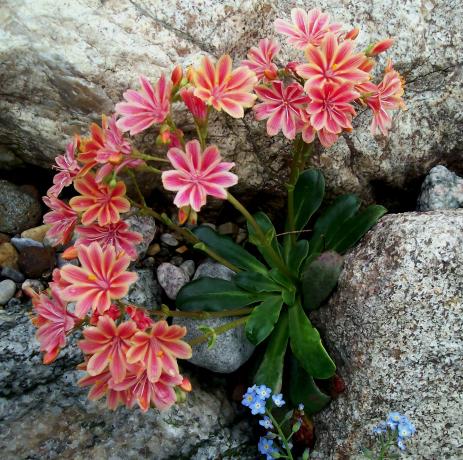Please introduce yourself.
I live on a small farm in northern Indiana with my husband, Robert. I am a self-taught gardener, gleaning information from books, magazines, trial and error, and many wonderful people who are willing to share their knowledge. Robert and I enjoy seeing plants in their natural habitat, and visiting botanical gardens, nurseries, and private gardens. We belong to the Great Lakes Chapter of NARGS.
How did you get into gardening in general, and rock gardening in particular?
I grew up with gardening. Every year, my mom would let each child pick something exotic or fun from the seed catalog. I can remember vegetable spaghetti, peanuts, Indian corn, gourds, cotton, cacti, and giant watermelons. Rock gardening came much later, after marriage and buying a property. While raising a family, the gardening was centered around veggies and annuals, but then I started branching out into seed starting and perennials. I saw a brief article in a gardening magazine about rock gardening and one of the sources mentioned was Trenoll Nursery near Trenton, Ohio. We visited there and I was introduced to alpines by the owner, Dorothy Parker. I made a sizable purchase and, as we were leaving, Dorothy stuffed a grocery bag in my arms. It was half full of NARGS quarterlies, each full of pictures of incredible plants that I never dreamed existed... I was hooked!
Many NARGS members will be familiar with you as a vendor at various AGMs. How did you get started with the nursery?
I enjoy seed starting and propagating and found out I could not only support my hobby but also expand it by turning it into a business. Sometimes it is a fine line between the two.
You garden in northern Indiana, about as far from mountains as it is possible to be. Can you describe your climate and any challenges to growing alpines in these conditions?
Describe the climate in Indiana? After a hot, dry summer in 2022, we received 5.5 inches (14 cm) of rain in one hour on the first of August. It’s usually one extreme or the other. With well-drained potting mix and sand beds we can deal with the precipitation. It’s the hot, humid, weather in the summer and freezing and thawing in January that cause the most damage.
You grow some pretty amazing plants, but perhaps the most impressive is your incredible Physoplexis comosa. What’s your secret to getting this beautiful species to thrive?
I honestly don’t know. Getting viable seed is the first hurdle. Physoplexis germination is easy with GA3 and or chilling. Nursing the tiny little plants thru the first year is a challenge. After that, just watch out for slugs. And whatever you do, don’t ever brag about blooming it! I did that the year it had 23 flower heads, and ever since it has produced just a measly three or four.
If you had to pick just five must-have rock garden plants, what would they be?
Everyone knows how difficult a choice this is, and it changes frequently. Today the favorites would be:
Gentiana acaulis, the rock garden classic with huge, blue flowers.
Soldanella, a native of European mountains with delicate lavender bells early in the spring.
Aquilegia scopulorum, one of the dwarf columbines from western North America. It is one of the first alpines I bloomed from seed and still a favorite.
Lewisia, the western American succulent with spectacular floral displays.
Corydalis hamata is one that I’ve never grown, but it has been on my ‘must get’ list ever since I first saw pictures.
I feel like every rock gardener has a different soil mix that they love. What’s yours?
For seed germinating, I use equal parts calcined clay, perlite, and commercial peat-based germinating mix. I use this for most seeds, even my vegetables. The mix falls off the roots at transplanting time; you can successfully transplant poppies out of it.
For pot growing, we have used several different mixes formulated for green roof plantings. The current one we are using has a large percentage of expanded shale plus a little bark.
And finally, if you could go back in time and visit yourself when you were first starting rock gardening, what advice would you give?
Drainage, drainage, drainage. I progressed from adding a little sand to my soil to just forgetting the soil and using the sand!
Thank you Esther!
Know a rock gardener you’d like to see interviewed in the Quarterly? Let me know via the Contact Us page on NARGS.org

